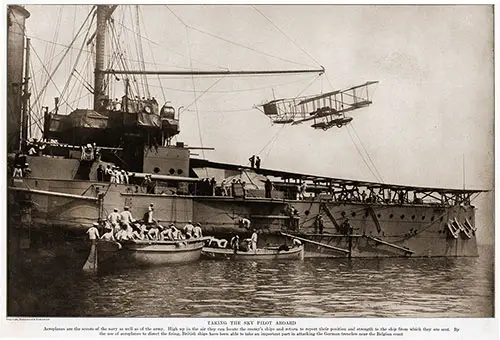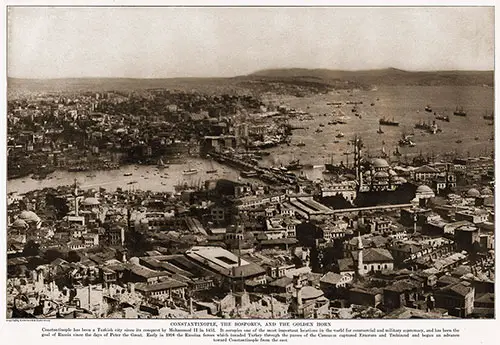WW1 Photos: Collier's Photographic History of the European War - 1916
Photographs and Other Images Sourced from the Book Collier's Photographic History of the European War, 1916. A part of a World War 1 Online Exhibit at the GG Archives.

Front Cover, Collier's Photographic History of the European War: Including Sketches and Drawing Made on the Battle Fields, 1916. GGA Image ID # 189536a826

Title Page Announcing Photographs by the Official Photographers Accompanying Each Army, Collected and Arranged by Francis J. Reynolds and C. W. Taylor, and Published by P. F. Collier & Son, New York. Collier's Photographic History of the European War, 1916. GGA Image ID # 18955c72c4

Portrait Photograph of George V, King of Great Britain and Ireland, and Emperor of India. Collier's Photographic History of the European War, 1916. GGA Image ID # 18955f367d

Confident Leaders of the Allies from Left to Right. General Joffe, President Poincare. King George V, General Foch. Hero of the Marne and Leader of the French Forces in the Battle of the Somme, and General Sir Douglas Haig, Commanding the British Forces in France. Photograph © American Press Association. Collier's Photographic History of the European War, 1916. GGA Image ID # 189594711a

Earl Kitchener, Lloyd-George, and General Roque. Earl Kitchener (left) Was Drowned in June. 1916. When the Cruiser Hampshire Went down near the Orkneys. Lloyd-George (right) Succeeded to Kitchener’s Post of Secretary for War Early in July. Directly behind Lloyd-George Is General Roque, Who Succeeded Gallieni as French Minister of War. Photograph © Modern Photo Service. Collier's Photographic History of the European War, 1916. GGA Image ID # 1895b74913

Taking the Sky Pilot Aboard. Aeroplanes Are the Scouts of the Navy as well as of the Army. High up in the Air They Can Locate the Enemy's Ships and Return to Report Their Position and Strength to the Ship from Which They Are Sent. by the Use of Aeroplanes to Direct the Firing, British Ships Have Been Able to Take an Important Part in Attacking the German Trenches near the Belgian Coast. Photograph © Underwood & Underwood. Collier's Photographic History of the European War, 1916. GGA Image ID # 1895d18018

The French Battleship, Bouvet. One of the Battleships Sunk by the Turkish Forts, in the Earlier Part of the Fighting to Force the Dardanelles, Long Considered Impregnable. the French and English Immediately Sent Other Ships to Replace Those That Were Sunk or Disabled. Photograph © American Press Association. Collier's Photographic History of the European War, 1916. GGA Image ID # 18962e90b5

The Lusitania Leaving Her Pier at New York. This Magnificent Cunard Liner Was Torpedoed by a German Submarine, Ten Miles from Kinsale Head on the Irish Coast. 7 May 1915. the Ship Sank in Eighteen Minutes. in This Terrible Wreck 1.150 People, among Whom Were 114 Americans, Lost Their Lives. the Wholesale Slaughter of Non-combatants without Warning or Opportunity for Escape, in Defiance of International Law and the Precedents of War between Civilized Nations, Aroused the Deepest Indignation. Photograph © International News Service. Collier's Photographic History of the European War, 1916. GGA Image ID # 189680cca0

The Italian Liner Ancona Leaving New York. On 9 November 1915, the Question of Illegal Warfare by Submarines Was Reopened When the Italian Line Ancona, Bound for New York, Was Sunk in the Mediterranean by an Austrian Submarine. among the Passengers Who Perished Were Several American Citizens. Photograph © Underwood & Underwood. Collier's Photographic History of the European War, 1916. GGA Image ID # 1896959db8

Constantinople, the Bosporus, and the Golden Horn. Constantinople Has Been a Turkish City since Its Conquest by Mohammed Mohammed II in 1433. It Occupies One of the Most Important Locations in the World for Commercial and Military Supremacy and Has Been the Goal of Russia since the Days of Peter the Great. Early in 1916, the Russian Forces Which Invaded Turkey through the Passes of the Caucasus Captured Erzerum and Trebizond and Began an Advance toward Constantinople from the East. Photograph © Underwood & Underwood. Collier's Photographic History of the European War, 1916. GGA Image ID # 1896a60ce3

The War in Africa. The British and German Possessions in Africa Have Already Taken Part in the World-Wide Conflict. Indeed, a Rearrangement of German, British, Portuguese, and French Possessions in Africa May Be Among the Important Results of the War. The Picture Shows a British Expeditionary Force Setting Out From Sierra Leone to Attack the Port of Duala, in the German Colony of Kameron. The View Is Taken at Freetown, and Shows the Transports in the Harbor, Together With the French Cruiser Druix. Photograph © American Press Association. Collier's Photographic History of the European War, 1916. GGA Image ID # 1896abd0ae
